Cities of Nepal
Major Cities and towns
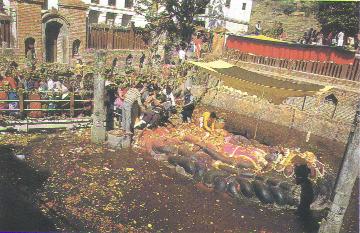
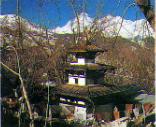
Other
Destination of Kathmandu Valley
Cities that has shaped the valey
Hills that surrounds the valley
Cities and towns - East of Kathmandu
Cities and towns - West of Kathmandu
Gorkha : The epicenter of the
unification of the Kingdom of Nepal.
Janakpur : The holy city
Lumbini : The birth place of
the light of Asia - Buddha
Tansen : The best of all
Newar Towns in the Kingdom
OTHER VALLEY DESTINATIONS
Carnivals, Parks & Temples
Balaju Water Gardens.
The Balaju Water Gardens have been the focus of several Nepali folk songs. The fish farm, the forests, the water falls and the plants here are beautiful, and the 22 sea-dragon spouts are a site of religious festivals. Located at the foot of Nagarjun Hill, it has plenty of water resources and is a favorite picnic spot.
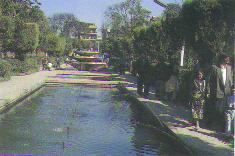 Budhanilkantha.
Budhanilkantha.
The Vishnu statue at Budhanilkantha was found buried in the ground in its original state. The statue is estimated to be about a thousand years old and shows Vishnu lying on the cosmic water before the universe was created. Shivapuri looms over Budhanilkantha and visitors find much peace there. You will be able to observe local people perform puja every morning and evening.
Chobhar Gorge.
Manjushri came upon a huge lake eons ago and saw a huge lotus emanating bright light at its center. So he cut a deep gorge in the wall of the lake and let the water out in order to observe and worship the lotus. The bed of the lake became Kathmandu Valley and the place where he cut the lake is said to be Chobhar. An intricate cave is located there as well as a Ganesh temple.
Dakshinkali.
The temple at Dakshinakali is dedicated to the ferocious mother goddess who has much energy and power. It is said that she gives strong will power and energy to those who come to her and she loves sacrifices. The temple is tantric in nature and is a favorite worship place of the Hindus. Saturdays are good days to visit as there is always a massive crowd of worshippers who come from all parts of Nepal to offer prayers.
Jawalakhel Zoo.
The zoo has improved a lot over the years and contains fine samples of Himalayan animal species. Tourists who may have problems seeing the one-horned rhino and the Royal Bengal tiger in the wild will have no problems observing them close-up at the Jawalakhel Zoo. The zoo is managed by the King Mahendra Trust for Nature Conservation.
Godavari Royal Botanical Garden.
This is perhaps the most popular picnic ground for the Kathmandu people. The plants are of wide variety and the flowers, when in bloom, make the atmosphere sparkle in colors. In fact, most of the Nepali film songs and dances are shot here. You may wish to visit the Nau and Panch Dhara ponds or take a hike up the 2,700 meter Pulchowki Hill nearby.
Cities
Kakani.
Lying to the northwest of Kathmandu and only an hour's drive away from the capital, the hill top is recommended for its quiet surroundings and skyline views of Gauri Shanker, Langtang, Choba Bhamare, Ganesh Himal, Manaslu, and Himalchuli.
 Nagarkot.
Nagarkot.
At a height of 2,099 meters above sea level, the hill top is visited for viewing beautiful sunrises and sunsets and visitors take delight in the layout of the Kathmandu Valley below. On a clear day Manaslu, Ganesh Himal, Gauri Shanker, and Everest can be seen from here. Lodges and resorts are open throughout the year and visitors can extend their sojourn to explore the countryside.
Dhulikhel.
This old Newar town lies beyond the eastern rim of the Valley with comfortable lodgings for extended trips. Mountain bikers will appreciate the route that takes them up to Dhulikhel, to Namobuddha shrine, and down to the old town of Panauti. The ride can be completed in one day.
Sankhu.
Sankhu is a sleepy town beneath the Gum Bihar religious complex. Within the complex is the temple of Bajra Yogini built in the 17th century. The area has been an important religious site since the 4th century and has excellent woods and bird-life as well as charming monkeys and pigeons in the temple area. Visitors may wish to bike up to Nagarkot and come down biking to Sankhu.
Hills
Pulchowki.
About 2,700 meters above sea level, Pulchowki is the tallest hill top surrounding the Kathmandu Valley. Visitors will enjoy bird-watching and nature hikes in the thick forests. More than 250 bird species have been sighted here as well as barking deer, leopard, and bear.
Chandragiri.
Provides excellent hikes and a commanding view of the Kathmandu Valley. The best approach is from Hattiban. Though the vegetation is sparse, the culture is rich and you will see farmers, houses, and rice fields as you climb up. However, the upper reaches of Chandragiri are dry and uninhabited. Be sure to take plenty of water.
Nagariun.
It is named after a famous sage. There is a stupa at the top and the forest is well known for its animal life. Controlled by the army, the animal life is protected here and the forest is also known as the Queen's Forest. Leopard, deer, birds, squirrel, and other animal species may be seen and the hill tracks are perfect for mountain biking as well.
Shivapuri.
Shivapuri provides most of the water to the Kathmandu Valley and among the hills, it is closest to the high Himalaya. The wildlife sighting here is also excellent as the park has access to wider lands and areas behind the Kathmandu Valley. You may wish to visit the Buddhist monastery set high on the hill.
OTHER PLACES OF INTEREST
EAST OF KATHMANDU
Dharan:
Dharan lies right at the foot of the hills, but the transformation when coming from the Terai is dramatic. This is unquestionably a hill town with hill people-there are scarcely any dark-skinned plains people to be seen. Dharan is a bustling bazaar town that has grown rapidly.
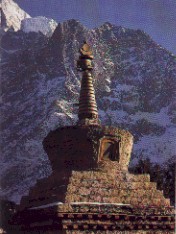 Dhankuta:
Dhankuta:
Although Dhankuta is only 75 km by excellent road from the Terai, it seems more like a million miles. Dhankuta is quite a large town, and although there is no specific attraction, there are good views, a mild climate and plenty of interesting walks in the surrounding area. The town owes its prosperity to the fact that it was a major recruiting center for the Gurkha regiments of the British Army and quite a bit of British aid money has been spent in the vicinity.
Charikot/Jiri:
About 133 kilometers from Kathmandu, Charikot provides a spectacular mountain view of Gaurishanker. In the eastern upper part of Dolakha township there is a famous roofless temple of Dolakha Bhimsen.
Namche Bazaar:
The name Namche Bazaar is generally associated with Sagarmatha (Mt. Everest), the highest peak in the world. It is the entrance to the Everest region. Situated on the lap of the Khumbu Himal range, Namche Bazaar is about 241 km from Kathmandu.
Hile:
It is situated about 13 kilometers north of Dhankuta Bazaar. The panorama of the major peaks of the eastern Himalaya including. Sagarmatha (Mt. Everest) Makalu, Lhotse and Kumbhakarna can be enjoyed from Rile.
Antu Danda:
It is situated at an altitude of 1,677 m in 11am District and is famous for its unique views of Everest and Kanchenjunga. It is the best place for viewing the sunrise and sunset. There is a motorable road from 11am to Chhipitar from where one can reach Antu Danda on foot. NORTH OF KATHMANDU
Nuwakot:
The old fortress town of Nuwakot used to be an important strategic outpost. It controlled the ancient trade routes to Tibet and the kings of medieval Nepal maintained large garrisons here. Nuwakot offers terrific views of the mountains and thc surrounding rural scenery makes for an enchanting experience. There are a number of artistic buildings on thc hilltop which recall the traditional architecture of the Kathmandu Valley.
Helambu:
Helambu, situated about 72 kilometers north-east of Kathmandu, is famous for its scenic grandeur anc pleasant climate. There are many Bud. dhist monasteries amidst a rich anc enchanting landscape. Sundarijal is the starting point for trekking to Helambu which is only 11 kilometers away from Kathmandu.
Gosaikund/Langtang:
Gosaikund Lake is the site for a great pilgrimage in August each year - this is the height of the monsoon, not a pleasant time for trekking. The large rock in the centre of the lake is said to be the remains of a Shiva shrine and it is also claimed that a channel carries water from the lake directly to the tank at the Kumbeshwar Temple in Patan, 60 km to the south. More Info
WEST OF KATHMANDU
Manang:
The village itself is a compact collection of 500 flat-roofed houses separated by narrow alleyways. To Ireach a doorway you must ascend a steep log notched with steps. The setting of the village is most dramatic, with the summits of Annapurna and Gangapurna less than 8 km away, and Ia huge icefall rumbling and crashing on the flanks of the peaks. More Info
Baglung:
Baglung is now accessible by road from Pokhara. It is the main market place of Dhaulagiri zone and the gateway to Dhorpatan Hunting Reserve which is well-known as the habitat of blue sheep.
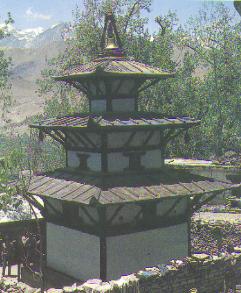 Muktinath/Jomsom:
Muktinath/Jomsom:
The famous temple of Lord Muktinath lies in the district of Mustang and is situated about 18 kilometers northeast of Jomsom at an altitude of about 3,749 meters. The temple is situated on a high mountain range and is visited during fair weather. There are two ways to get to Muktinath from Kathmandu. Either take a direct flight from Kathmandu via Pokhara to Jomsom and hike for a couple of hours via Kagbeni or trek all the way from Pokhara. There is also an air service from Pokhara to Jomsom. More Info
Mustang:
Jomsom is the district headquarters for the Mustang region of Nepal. To many people, however, Mustang implies the area of Nepal that extends like a thumb into Tibet. This is the region described in Michel Piessel's book Mustang, and includes the walled capital city of Mustang, Lo Mantang. More Info
Dolpo:
Dolpo is the most remote and least developed district in Nepal. Although a few anthropologists and geographers had explored the region, the entire district was closed to trekkers until 1989 when the southern part of Dolpo was opened to organised trekking groups. Peter Matthiesen's The Snow Leopard and Snellgrove's Himalayan Pilgrimage have contributed to the mystique and attraction of Dolpo. More Info
Humla/Jumla:
Jumla, on the banks of the Tila River at 2370 metres; is one of the highest rice growing areas in the world. The entire Tila Valley is covered with paddy fields growing a unique red rice that is more tasty than white rice, but is scorned by most local people. The people in this region speak their own version of Nepali. The people throughout the region are Thakuris, and also Chhetris who have the highest social, political and ritual status.
GORKHA
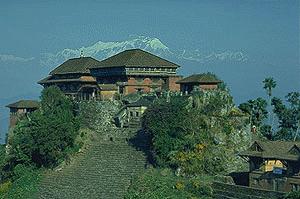 Gorkha is a
hill bazaar and the ancestral home of the Shah dynasty which rules Nepal today. It is from
here that King Prithvi Narayan Shah started his conquest of the country's various tiny
kingdoms and unified them into a single nation, Nepal. Perched one thousand feet above
Gorkha Bazaar, the palace dominates the surroundings and is visible from all around the
area. It is regarded as a holy shrine by many and from here, visitors can get fantastic
views of lush green valleys and the Himalaya beyond. The palace also boasts beautiful
architecture.
Gorkha is a
hill bazaar and the ancestral home of the Shah dynasty which rules Nepal today. It is from
here that King Prithvi Narayan Shah started his conquest of the country's various tiny
kingdoms and unified them into a single nation, Nepal. Perched one thousand feet above
Gorkha Bazaar, the palace dominates the surroundings and is visible from all around the
area. It is regarded as a holy shrine by many and from here, visitors can get fantastic
views of lush green valleys and the Himalaya beyond. The palace also boasts beautiful
architecture.
Even though only Hindus are allowed to enter the palace premises, it is worthwhile walking up the stairs for the view. A holy cave is situated just below the palace where once lived a saint named Gorakhnath from which the town earned its name. Visitors will enjoy strolling around Gorkha Bazaar which is located below the palace. Its fine architecture and cobbled lanes are reminiscent of a time long forgotten.
To get to Gorkha from Kathmandu, rented cars, taxis or public buses are available at the main bus station at Gongabu. Visitors should buy their tickets in advance since the buses leave at 7 am every morning. On your arrival in Gorkha, you can make a selection from a wide range of lodgings which provide cheap as well as expensive accommodations.
JANAKPUR
 Janakpur is the capital of the ancient state
of Mithila and the Janaki Temple, located in the center of the city, is well known in the
Hindu Kingdom. Sita the wife of the legendary hero Ram was born in Janakpur. Throughout
the year, many pilgrims come to pay their respects to Ram and Sita who are the main
religious attractions in Janakpur. The city is thronged by worshippers and visitors alike
especially during the festival of Bibah Panchami. This annual festival is celebrated on
the occasion of Ram and Sita's marriage and their wedding ceremony is enacted throughout
the week. During this period, the city is enlivened by the wedding festivities.
Janakpur is the capital of the ancient state
of Mithila and the Janaki Temple, located in the center of the city, is well known in the
Hindu Kingdom. Sita the wife of the legendary hero Ram was born in Janakpur. Throughout
the year, many pilgrims come to pay their respects to Ram and Sita who are the main
religious attractions in Janakpur. The city is thronged by worshippers and visitors alike
especially during the festival of Bibah Panchami. This annual festival is celebrated on
the occasion of Ram and Sita's marriage and their wedding ceremony is enacted throughout
the week. During this period, the city is enlivened by the wedding festivities.
Ram and Sita (Janaki) are the two central characters of the great Hindu epic Ramayan. In the story, Ram strings a bow that originally belonged to Lord Shiva the Destroyer and in the process, the bow breaks into three pieces. One piece flies up to heaven. Another falls down into the depths of the underworld. Today, there is a huge pond called Dhanush Sagar above the very spot. The third piece flies to present day Dhanushadham, about 40 kilometers from Janakpur. There, visitors will see huge rocks shaped liked a bow. Thus, after Ram's successful attempt to string the bow, Janaki's father, King Janak gives his daughter's hand in marriage to the brave prince of Ayodhya.
LUMBINI
 Shakyamuni Buddha was born in Lumbini, in southern Nepal, twenty-five
hundred years ago. Since his time, Nepal has been a sacred ground for Buddhists as the
birthplace of the Buddha. Lumbini is a small town in the southern Terai plains of Nepal,
where the ruins of the old city can still be seen. Shakyamuni Buddha was born to a royal
family. His mother, Queen Maya Devi, had a dream foretelling his coming. In her dream, she
saw a white elephant with nine tusks come down to her from the heavens and enter her body.
Shakyamuni Buddha was born in Lumbini, in southern Nepal, twenty-five
hundred years ago. Since his time, Nepal has been a sacred ground for Buddhists as the
birthplace of the Buddha. Lumbini is a small town in the southern Terai plains of Nepal,
where the ruins of the old city can still be seen. Shakyamuni Buddha was born to a royal
family. His mother, Queen Maya Devi, had a dream foretelling his coming. In her dream, she
saw a white elephant with nine tusks come down to her from the heavens and enter her body.
When the time of his delivery approached, she left for her parental home, according to the practice of the time. En route to her parents' home, she gave birth to Siddhartha Gautam in the gardens of Lumbini.
The prince is said to have emerged from her right side as she rested her arm on the branch of a fig tree. And immediately after birth, he took seven steps in the four cardinal directions and wherever his feet touched the ground, a lotus bloomed.
After this powerful birth, Prince Siddhartha lived in his father's palace, shielded from the evil and the pain of the outside world. His father had been informed by the seers of the time that the prince would either become a great emperor or become a holy man. Fearing his son would leave the world for religious practice, the king took pains to see that Prince Siddhartha neither saw nor experienced suffering. Thus he hoped Siddhartha would become a great emperor and never dream of leaving the kingdom.
But Siddhartha - who had lived a life of isolated royal splendor -inevitably ventured beyond the castle walls one day. Outside these walls he came across sorrow, pain, death and a man whose life was devoted to releasing others from those sufferings. He saw a beggar, a cripple, a corpse, and a holy man. These encounters affected the young prince deeply, awakening a deep desire to find the ultimate cause of suffering and thus alleviate it. One night, when all were asleep inside the palace, he escaped. He cast aside his princely garments, cut his hair, and began the life of a wandering ascetic.
For years he fasted, meditated and spent his time in a rigorous and painful search to find a way to end suffering. On a full-moon night in the north Indian town of Bodhgaya, as he meditated under a tree, Siddhartha had a direct realization of nirvana, eternal peace. This transformed the mortal prince into a Buddha.
He spent the rest of his life guiding people towards nirvana, love, and friendship. When it was time for him to leave this world, he had thousands of followers to keep Buddhism alive. He left this world (a person who has attained nirvana is freed from the cycle of life and death) at the age of 84, having exhausted his human body for the sake of all sentient beings.
Lumbini has since been a holy ground for Buddhists all over the world. The restored garden and surroundings of Lumbini have the remains of many of the ancient stupas and monasteries. A large stone pillar erected by the Indian Emperor Ashoka itt 250 BC bears an inscription about the birth of the Buddha.
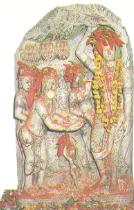 An important part of Lumbini is
the temple of Maya Devi. It has a stone image of Maya Devi giving birth to Lord Buddha as
she holds onto a branch. It has been well worn by the strokes of barren women hoping for
fertility. To the south of the temple is a pool where Queen Maya Devi is said to have
bathed and given her son his first purification bath.
An important part of Lumbini is
the temple of Maya Devi. It has a stone image of Maya Devi giving birth to Lord Buddha as
she holds onto a branch. It has been well worn by the strokes of barren women hoping for
fertility. To the south of the temple is a pool where Queen Maya Devi is said to have
bathed and given her son his first purification bath.
A quiet garden, shaded by the leafy Bo tree (the type of tree under which Buddha received enlightenment), and a newly planted forest nearby lend an air of tranquility which bespeaks Buddha's teachings. Lumbini is now being developed under the Master Plan of the Lumbini Development Trust, a non-governmental organization dedicated to the restoration of Lumbini and its development as a pilgrimage site. The plan, completed in 1978 by the renowned Japanese architect Kenzo Tange, will transform three square miles of land into a sacred place of gardens, pools, buildings, and groves. The development will include a Monastic Zone, the circular sacred Garden surrounding the Ashoka pillar and Maya Devi temple, and Lumbini Village, where visitors will find lodges, restaurants, a cultural center and tourist facilities.
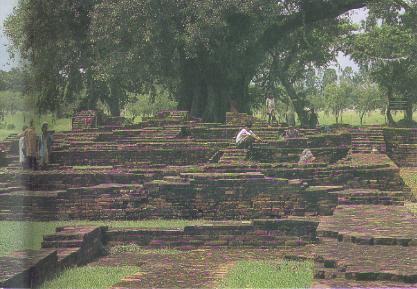 An important archeological site near Lumbini, Kapilvastu evokes the ancient
palace where Lord Buddha spent his formative years. Scattered foundations of the palace
are abundant, and archeologists have by now discovered 13 successive layers of human
habitation dating back to the eighth century BC. A must for archeological and historical
buffs!
An important archeological site near Lumbini, Kapilvastu evokes the ancient
palace where Lord Buddha spent his formative years. Scattered foundations of the palace
are abundant, and archeologists have by now discovered 13 successive layers of human
habitation dating back to the eighth century BC. A must for archeological and historical
buffs!
Besides its religious and historical significance, Lumbini offers cultural insights into the village life of southern Nepal. If possible, try to coincide your visit with the weekly Monday bazaar when villagers come from miles around to buy grains, spices, pottery, jewelry, saris and various other items. It may appear as a scene out of the Arabian Nights, with colorful merchandise spread out under the mango trees and the air perfumed with incense. It's a chance to bargain for souvenirs while witnessing local life in Lumbini. Wooden ox-carts loaded with hay trundle by. Villagers dry cow-dung for fuel, and tea stalls serve sweet milk tea.
Today, Lumbini is beginning to receive travelers' and archaeologists' attention after centuries of neglect. Serious preservation work has only just been started in the latter half of this century and Lumbini as a slice of history is worth seeing and worth preserving. Royal Nepal Airlines and other airlines fly regularly to Bhairahawa, near Lumbini, and bus services are available from Pokhara and Kathmandu.
TANSEN
If visitors are wondering which place in this kingdom would give them a taste of everything, we suggest that they give Tansen a try. Tansen is a small town of approximately twenty thousand people. It is on the way from Pokhara to Lumbini, the birthplace of Lord Buddha, and it is not too far from the Royal Chitwan National Park. Located 4,300 meters above sea level, on the south flank of Srinagar Hill, the greatest attractions of this town are its ancient culture, friendly people, excellent mountain views, and, above all, its serene atmosphere. The weather remains moderate throughout the year, and it is a pleasant place to visit in any season.
 The town's mostly Newar and Magar inhabitants have long been known as
staunch warriors. The kings of Tansen wielded great power over western Nepal in the
fifteenth century. Palpa, their kingdom was the last to be defeated by the conquering
Gurkhas who unified today's Nepal. These people became even more famous in the Anglo-Nepal
war of the early I 800s. Col. Ujir Singh Thapa who commanded the army in the region was in
an extremely trying situation at the time. His men were outnumbered four to one by the
English forces. He desperately asked for divine help before going into battle, promising a
temple in the name of the mother Bhagwati (who is ferocious and loves blood sacrifices) if
she would help him. He won. In 1815, he kept his word and built a temple to the goddess.
However, fighting is not the only forte of Tansen residents.
The town's mostly Newar and Magar inhabitants have long been known as
staunch warriors. The kings of Tansen wielded great power over western Nepal in the
fifteenth century. Palpa, their kingdom was the last to be defeated by the conquering
Gurkhas who unified today's Nepal. These people became even more famous in the Anglo-Nepal
war of the early I 800s. Col. Ujir Singh Thapa who commanded the army in the region was in
an extremely trying situation at the time. His men were outnumbered four to one by the
English forces. He desperately asked for divine help before going into battle, promising a
temple in the name of the mother Bhagwati (who is ferocious and loves blood sacrifices) if
she would help him. He won. In 1815, he kept his word and built a temple to the goddess.
However, fighting is not the only forte of Tansen residents.
The jamre folk song performance of the Magars are colorful. Dancing and feasting are accompanied by drumbeats of the madal during festivals. Amar Singh Thapa, another great champion of the Anglo-Nepal war, had great affinity for Tansen as well. He brought highly skilled artisans from Kathmandu Valley to build the Amar Narayan temple when he was the governor of the town. The temple's woodcarvings are remarkable and puja is offered here everyday to Bishnu.
During the time of the Rana prime ministers., from 1846 to 1951, Tansen became an important outpost. Those who offended the administration or were political prisoners were sent away from the Kathmandu Valley beyond Tansen. It was thought that they would not be able to cause problems to the rulers from their faraway exiles. Later the Ranas tried to develop Tansen into a hill-station and built palaces and mansions for personal use. One such palace in the heart of the town has a huge door called the Bag gi Dhoka. Some say that it was built so that Khadga Shumsher Rana would not need to get off his elephant while entering the palace. Others claim that it was built so that horse drawn chariots could easily enter the palace grounds. The town's intricately patterned dhaka is the most popular handwoven cloth of Nepal. Newar women of the Kathmandu Valley have preferred its shawls for many decades. Nepal's national cap, the topi, is also made of dhaka. Dhaka is available to buyers at the town's bazaars. Those interested may also see weavers at work on their looms.
There are potters and metal workers in Tansen too. Earthen pottery is still used in many houses of Tansen. Jugs, basins, and even filters are made from clay for local use. Chang, the local liquor, is wonderfully cool if it has been stored in earthen-ware. Metal workers make deep plates, karuwa water Jugs, utensils for worship and hookahs for smoking.
Tansen is charming because it is unspoiled by modernity, pollution and urban bustle. On clear days, mountain views from the town reveal Dhaulagiri, Annapurna, Manaslu, Gauri Shankar and other peaks and a walk up to Srinagar Hill provides an even more thrilling Himalayan panorama.
Several hotels are located in Tansen. The number of travelers to this "hill station" have increased over the years, and so have tourist facilities. Indeed! Tansen is he perfect answer to those who wish to get an overall taste of Nepal.

